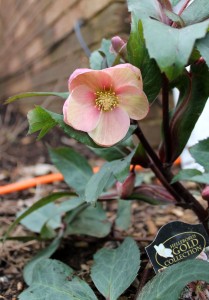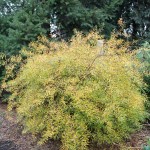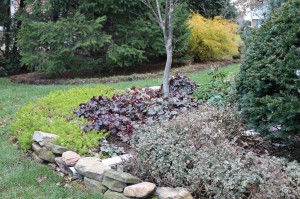Confused Plants
January 10th, 2012
I was out inspecting the botanical troops over the weekend, and two things struck me.
One is that the landscape is unusually colorful for this time of year.
And second is that some of my plants are doing odd things they’re not supposed to be doing in early January.
A nice surprise was the beautiful pink flower – just one – on my new helleborus (Lenten rose) ‘HGC Pink Frost.’ There it was – open in full glory among its still green and glossy foot-tall foliage.
Helleborus are normally the first perennials to open for the season, but I didn’t think we were there yet. A January-blooming perennial is strange, but I’ll take it.
Then on the opposite, western side of the house, I noticed a big, fat flower bud on my ‘Perfume Delight’ rose, looking to be just days from popping open. The plant still has some green leaves, too.
I can’t decide if the confused thing thinks it’s still fall or whether it’s already starting on 2012’s bloom. Ditto for the ‘Pink Chablis’ lamium, which also are blooming pink with more buds on the way.
The Virginia sweetspires also haven’t lost all of their deep-red fall leaves yet, but the showiest “hanger-on-er” is my spirea ‘Ogon’ (Mellow Yellow).
This superb shrub with the narrow, willow-like foliage is an eye-grabber all growing season with its bright golden color. But it’s supposed to turn russet-gold in fall, then drop its leaves for winter.
The plant turned slightly russet back in November, but it’s stayed in peak fall form ever since. It’s still a loose, russet-gold ball of four-season fire here in early January. I guess it hasn’t turned sufficiently cold enough for Mellow Yellow to realize fall is gone, and it’s time to call it quits.
I’ve heard of similar odd plant-bloom gymnastics going on elsewhere, such as at the U.S. National Arboretum in Washington, where the snowdrop bulbs are already in flower. Jamie Shiffer, the operations manager over at Hershey Gardens, tells me they’ve got bulb foliage poking up and a few roses blooming, too.
The lack of any searing cold winds and single-digit temperatures has boded well for broadleaf evergreens, which often brown around the edges when snow cover doesn’t protect them.
Despite the lack of cover, my evergreen shrubs such as camellias, nandina, boxwoods and hollies are looking pristine.
Two in particular looking better than ever are leucothoe ‘Rainbow,’ an arching little shrub that’s now a deep blood red, and osmanthus ‘Goshiki,’ a holly look-alike that’s now a variegated combo of light green and creamy white.
Is it time to start thinking gardenias in Harrisburg?
Even more striking are the evergreen perennials dotted around my yard.
A lot of people don’t realize that there are a fair number of perennial flowers that don’t die back to the ground for winter. Species such as helleborus, liriope, coralbells, lamium, ajuga and some of the creeping sedums are examples of perennials that hold their leaves to varying degrees over winter.
This year, all of those are still in mid-season form in my yard, while a few usual fall-droppers still haven’t defoliated.
My patch of barrenwort ‘Rubrum,’ for example, is brown, but the heart-shaped leaves are mostly intact and looking better than January’s usual bareness.
My two St. Johnsworts ‘Albury Purple’ are still holding onto vibrant deep-purple leaves with no signs of browning yet. I’d guess it’s October from the look of them.
And best of all is a patch of creeping sedum ‘Angelina’ next to a swoop of coralbells ‘Dolce’ planted under a cutleaf Japanese maple. The sedum is still full and bright gold in color, while the neighboring coralbells are deep purple/burgundy.
Who’d guess it’s January from the look of that?
We’ve still got a lot of winter ahead of us, and I suspect we’ll get nailed at least a time or two before it’s over.
But I’m liking what I’m seeing in this confused landscape so far.











